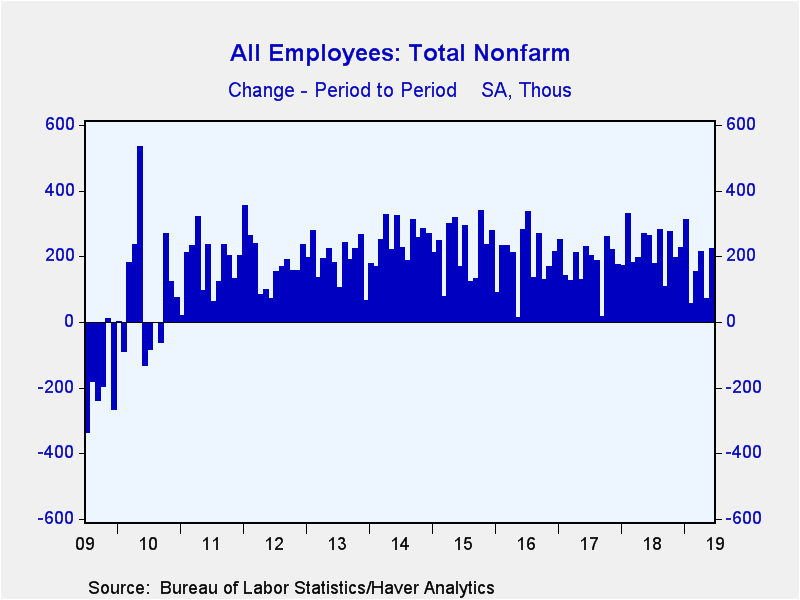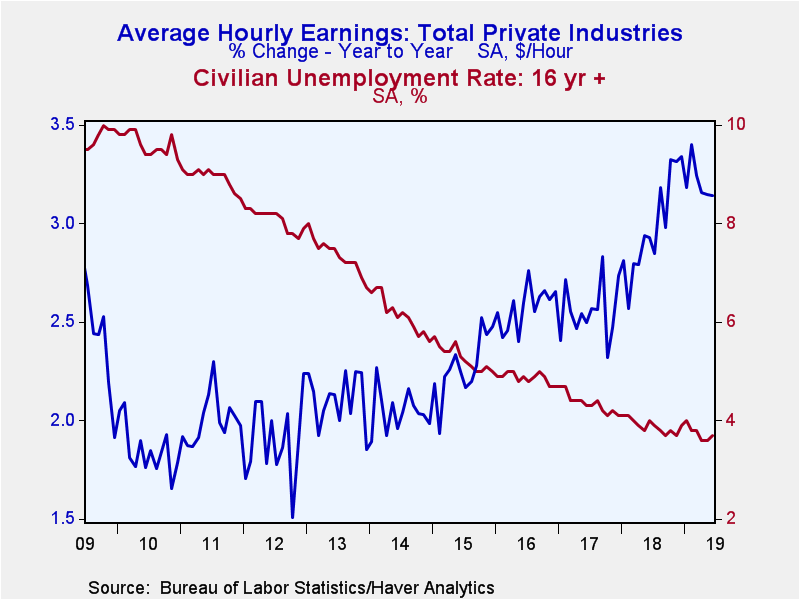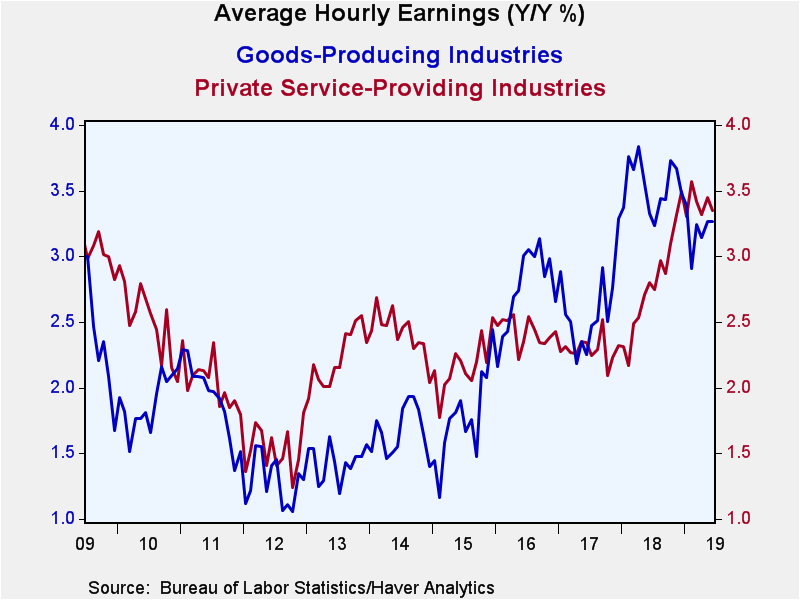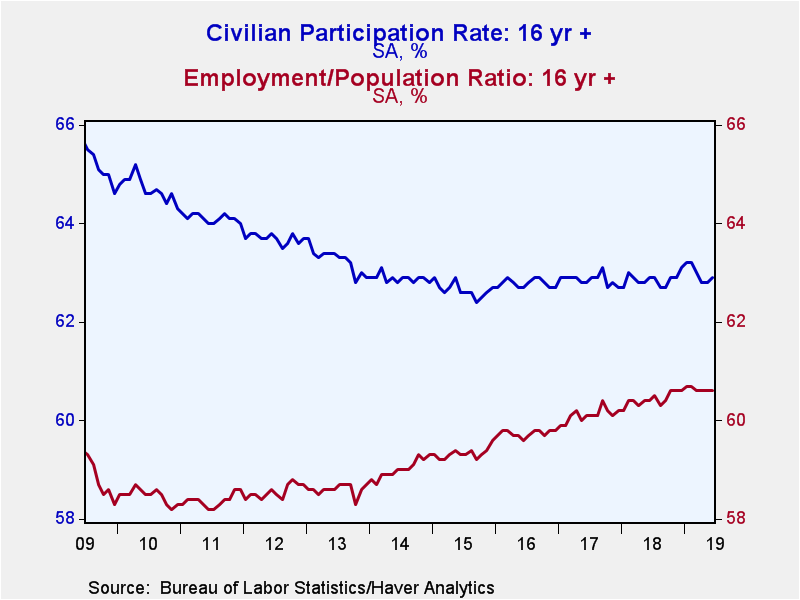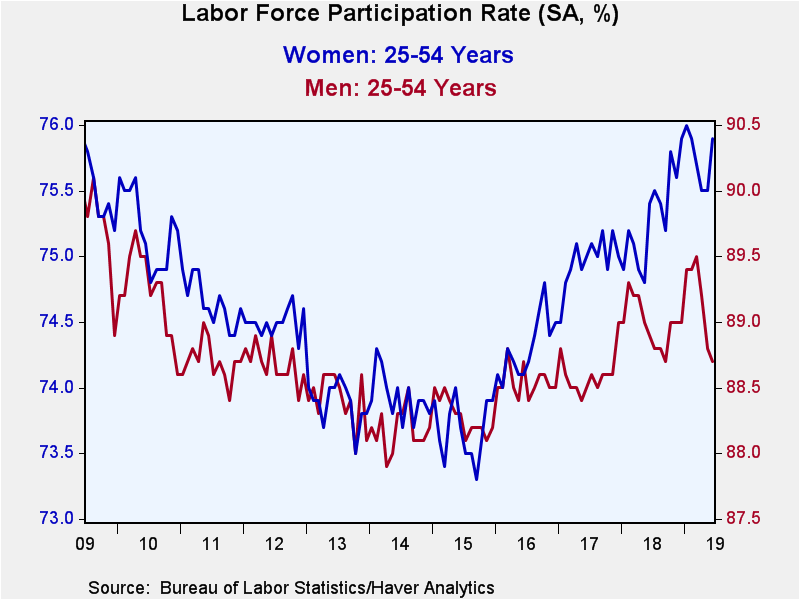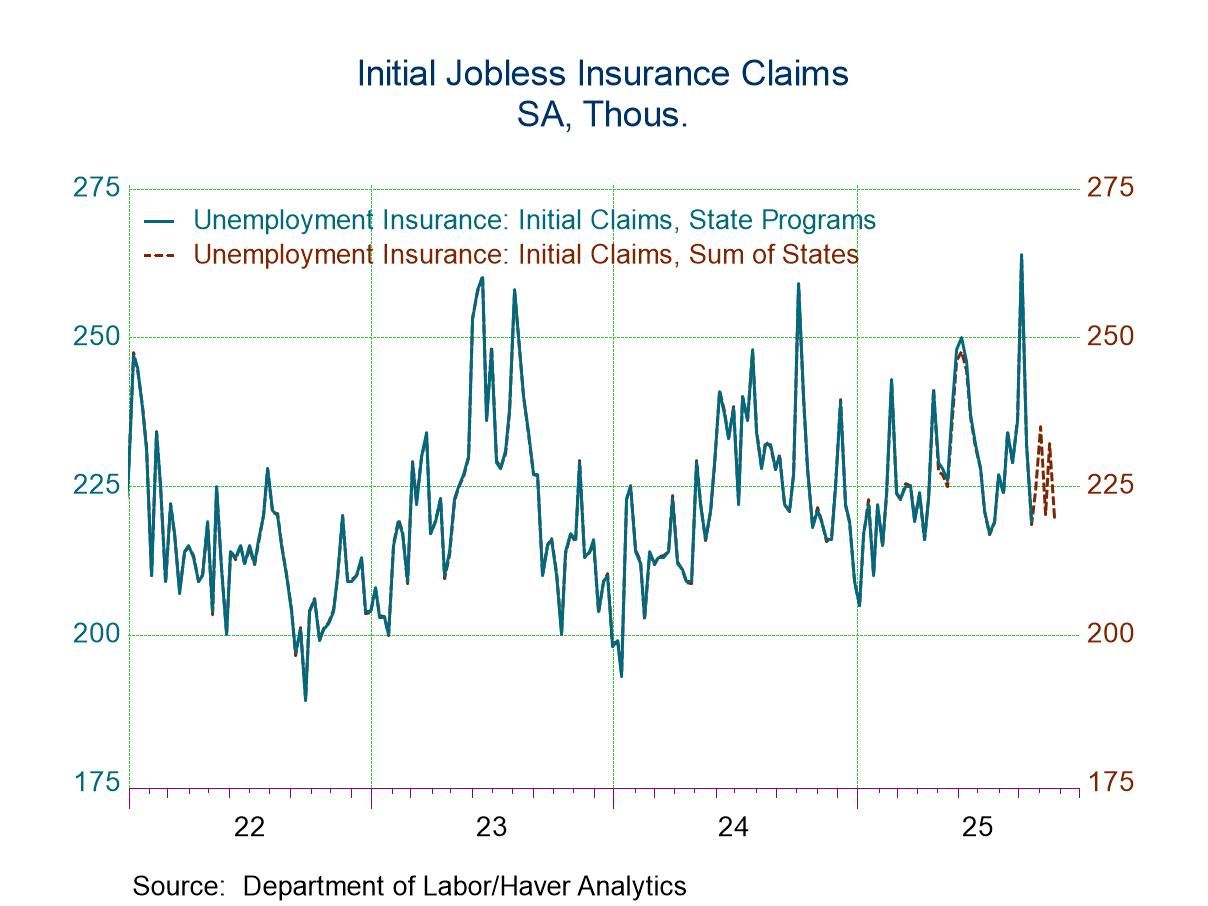 Global| Jul 05 2019
Global| Jul 05 2019U.S. Payroll Increase Unexpectedly Strengthens; Earnings Growth Slips
by:Tom Moeller
|in:Economy in Brief
Summary
Job growth rebounded during June. Nonfarm payrolls increased 224,000 (1.5% y/y) last month following a 72,000 May rise, revised from 75,000. So far this year, payrolls have risen an average 172,000 per month after a 223,000 monthly [...]
Job growth rebounded during June. Nonfarm payrolls increased 224,000 (1.5% y/y) last month following a 72,000 May rise, revised from 75,000. So far this year, payrolls have risen an average 172,000 per month after a 223,000 monthly average rise last year. The April increase was revised to 216,000 from 224,000. The June rise in payrolls exceeded expectations for a 165,000 gain in the Action Economics Forecast Survey. Average hourly earnings in the private sector increased 0.2%, after a 0.3% May rise and an April increase of 0.1%, each revised from 0.2%. Growth during the last twelve months of 3.1% was below the recent peak of 3.4% logged in February.
The unemployment rate edged higher to 3.7%. Stability at 3.6% had been expected. Employment in the household survey rose 247,000 and the labor force increased 335,000. The overall jobless rate, including those who were marginally attached or working part-time for economic reasons, edged higher to 7.2% from May's eighteen-and-a half year low.
From the payroll survey, the 224,000 increase in June employment reflected a 21,000 gain in the number of construction jobs which was improved from 5,000 in May. The rise in factory sector employment also improved sharply to 17,000. Employment in the mining & logging sector eased 1,000 (+3.1% y/y): growth has been sluggish all year.
Private service sector employment increased 154,000, but the 134,000 average monthly rise this year is below last year's 163,000 average. The gain last month was held back by a 5,800 decline (-0.4% y/y) in the number of retail jobs. Leisure & hospitality employment gained a reduced 8,000 (2.0% y/y), while professional & business services jobs rose an improved 51,000 (2.2% y/y). Temporary help employment gained a modest 4,300 (0.9% /y). Remaining firm was the increase in education & health services employment, up 61,000 (2.6% y/y), led by the health care sector. The number of financial jobs rose a weakened 1.0% y/y.
Government sector employment rose 33,000 and recovered May's decline. The rise was led by a 29,000 increase (0.9% y/y) in local area jobs which followed a May shortfall. State government jobs rose 2,000 (-0.2% y/y) after falling for three straight months. Federal sector employment also increased a steady 2,000 (0.6% y/y) with no hiring of temporary Census workers.
Average hourly earnings in the private sector rose 0.2%. The 3.1% y/y increase remained off its peak, but above the 3.0% and 2.6% growth rates in 2018 and 2017, respectively. Private service producing earnings rose a steady 0.3% (3.2% y/y) led by improved 0.4% gains in both financial activities (3.7% y/y) and professional & business services (3.4% y/y). Leisure & hospitality sector earnings rose 0.2% after a 0.5% strengthening (3.8% y/y), but information sector pay declined 0.2% (+5.0% y/y). Factory sector earnings rose 0.3% and by an accelerated 2.3% y/y, while construction sector earnings edged 0.1% higher (3.2% y/y).
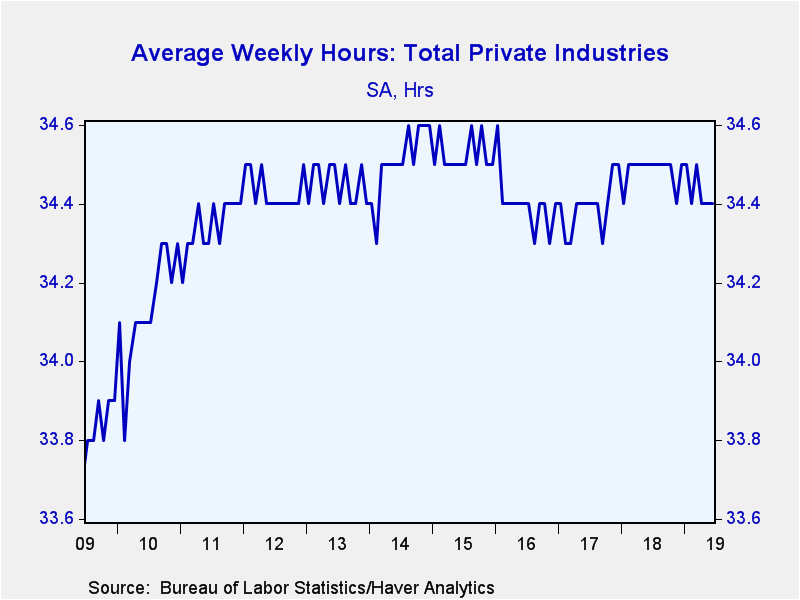 The length of the average workweek held steady at 34.4 hours,
where it's been for the last three months. Hours in the mining & logging
sector rose to 46.4, while in the factory sector, hours also improved to 40.7.
This remained well below the manufacturing cycle's peak last summer. The
construction sector workweek also improved to 39.3 hours but remained below last
year's peak 41.0 hours. Private service-sector hours held steady at 33.3, where
they've been since the middle of last year. Information services held at an
increased 36.4 hours as did professional & business services at 36.3 hours.
Education & health services hours also held at 33.0, but leisure &
hospitality remained low at a strengthened 25.9 hours.
The length of the average workweek held steady at 34.4 hours,
where it's been for the last three months. Hours in the mining & logging
sector rose to 46.4, while in the factory sector, hours also improved to 40.7.
This remained well below the manufacturing cycle's peak last summer. The
construction sector workweek also improved to 39.3 hours but remained below last
year's peak 41.0 hours. Private service-sector hours held steady at 33.3, where
they've been since the middle of last year. Information services held at an
increased 36.4 hours as did professional & business services at 36.3 hours.
Education & health services hours also held at 33.0, but leisure &
hospitality remained low at a strengthened 25.9 hours.
From the household employment survey, the rise in the unemployment rate to 3.7% reflected mix amongst age groups. The teenage jobless rate remained stable at 12.7%, and the rate for those aged 20-24 declined to a cycle low of 6.3%. The unemployment rate for individuals between 25 and 54-years-old rose slightly from its 2000 low to 3.0%. The rate for those 55 and over increased to 3.0% from 2.7%.
The labor force participation rate increased slightly to an average 62.9%. For men aged 25-54, it edged down to 88.7%, meaningfully below the 89.5% peak during March. For women aged 25-54, it rose m/m to 75.9% and approached a 12-year high. The employment-to-population ratio held at 60.6%, but it remained well above the 2011 low of 58.2%. The number of people not in the labor force rose 0.6% y/y, well below the peak growth of 2.7% in 2012.
The unemployment rate for individuals without a high school diploma eased to 5.3%. For high school graduates but no college, it rose to 3.9%. For those without a college degree, it rose to 3.0%. For college graduates, the unemployment rate was 2.1% for the third straight month.
The labor market data are contained in Haver's USECON database. Detailed figures are in the EMPL and LABOR databases. The expectations figures are in the AS1REPNA database.
| Employment: (SA, M/M Change, 000s) | Jun | May | Apr | Jun Y/Y | 2018 | 2017 | 2016 |
|---|---|---|---|---|---|---|---|
| Payroll Employment | 224 | 72 | 216 | 1.5% | 1.7% | 1.6% | 1.8% |
| Previous Estimate | -- | 75 | 224 | -- | -- | -- | -- |
| Manufacturing | 17 | 3 | 3 | 1.3 | 2.0 | 0.7 | 0.1 |
| Construction | 21 | 5 | 34 | 2.7 | 4.6 | 3.6 | 4.1 |
| Private Service-Producing | 154 | 72 | 158 | 1.6 | 1.7 | 1.8 | 2.2 |
| Government | 33 | -11 | 21 | 0.6 | 0.4 | 0.6 | 0.9 |
| Average Weekly Hours - Private Sector | 34.4 | 34.4 | 34.4 | 34.5 | 34.5 | 34.4 | 34.4 |
| Private Sector Average Hourly Earnings (%) | 0.2 | 0.3 | 0.1 | 3.1 | 3.0 | 2.6 | 2.6 |
| Unemployment Rate (%) | 3.7 | 3.6 | 3.6 | 4.0 | 3.9 | 4.4 | 4.9 |
Tom Moeller
AuthorMore in Author Profile »Prior to joining Haver Analytics in 2000, Mr. Moeller worked as the Economist at Chancellor Capital Management from 1985 to 1999. There, he developed comprehensive economic forecasts and interpreted economic data for equity and fixed income portfolio managers. Also at Chancellor, Mr. Moeller worked as an equity analyst and was responsible for researching and rating companies in the economically sensitive automobile and housing industries for investment in Chancellor’s equity portfolio. Prior to joining Chancellor, Mr. Moeller was an Economist at Citibank from 1979 to 1984. He also analyzed pricing behavior in the metals industry for the Council on Wage and Price Stability in Washington, D.C. In 1999, Mr. Moeller received the award for most accurate forecast from the Forecasters' Club of New York. From 1990 to 1992 he was President of the New York Association for Business Economists. Mr. Moeller earned an M.B.A. in Finance from Fordham University, where he graduated in 1987. He holds a Bachelor of Arts in Economics from George Washington University.


